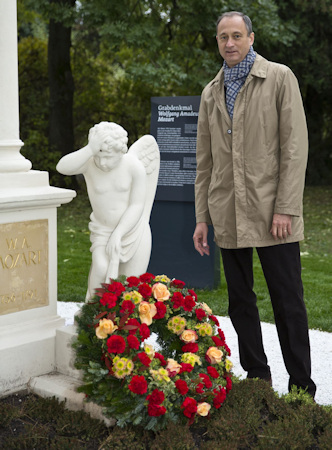
Contrary to popular belief, the location of Mozart’s grave in Vienna is not such a mystery after all. Sort of.
- Mozart was buried in the St. Marx cemetery (now a public park)
- A memorial gravestone marks the grave’s most likely site
- Easily found once inside the park
- The composer is almost certainly no longer in it
- Book a Mozart concert* for Vienna
- See also:
Where was Mozart buried?

(City councillor, Mr Mailath-Pokorny, at the newly-restored Mozart grave in St. Marx. Photo © PID / Georg Oberweger)
Mozart died on December 5th, 1791. As one newspaper of the time described it (my translation):
All of Vienna, and along with this Imperial city all of the musical world, mourns the untimely loss of this immortal man.
They buried the great composer in a standard, unmarked plot in the St.Marx cemetery (now a park) in Vienna’s third district. This was relatively normal practice at the time.
Note we’re not talking about a mass pauper’s grave, as often represented in popular media, but simply an unmarked one.
In fact, the idea of Mozart as some poor musician scraping by on handouts largely belongs to the realms of myth. He earned decent amounts of money (though he spent a fair deal, too, it must be said).

(The original Gasser memorial that used to mark the alleged site of Mozart’s grave, but later moved to its current location in the Zentralfriedhof)
Anyway, the problem is the word “unmarked”; not so much as a stray piece of sheet music identified the last resting place of one of history’s greatest composers. Equally, very few people apparently attended the actual burial: not even his wife.
This state of affairs later led to confusion as to the grave’s exact location.
Efforts were made, however, in the mid-1800s to identify the most likely site, and instructions given to cemetery staff to ensure that this location remained in good order. A proper memorial stone designed by Hanns Gasser went up there in 1859.
Gasser has another Mozart connection. He also worked on the main altar in the Waisenhauskirche; Mozart conducted the mass at the church’s consecration back in 1768.
So far so good, but we’re not at the end of the story.
To celebrate the centenary of Mozart’s death, Gasser’s memorial moved to the central cemetery (Zentralfriedhof) to join a cluster of musician’s graves featuring the likes of Beethoven and Schubert.
Which means if you see something looking like Mozart’s grave in the Zentralfriedhof, it’s just a monument and NOT the actual grave.
Meanwhile, back in St.Marx, a large stone slab eventually marked the grave’s location. Subsequent years saw the addition of further adornments that included a stone angel and column.
The current display results from restoration efforts in 1950, which repaired damage caused by WWII bombing (a not uncommon problem for Vienna’s historical sites), and further restoration in 2016.

(Mozart’s grave as pictured on a postcard from around 1905; produced by Verlag Reinhold Entzmann & Sohn; Wien Museum Inv.-Nr. 189939; excerpt reproduced with permission under the terms of the CC0 licence)
Burials at St. Marx ended in 1874, but the cemetery remains in good condition and serves as a rather wonderful park. The combination of nature and old gravestones has created a remarkably peaceful and unique look and atmosphere.
But there’s more…
Our story is still not over, though.
First, we’ll likely never know if the marked location truly is the actual plot where they laid Mozart to rest. We’re assuming the 19th-century Viennese got it right.
(If we look at life from the other direction, we do at least know where Mozart was born: Getreidegasse 9 in Salzburg, now a museum and a relatively easy day trip from Vienna if you’re interested in visiting.)

(Mozart’s grave in the St. Marx cemetery, as painted in 1943 by Oskar Laske; Wien Museum Inv.-Nr. 93882; excerpt reproduced under the terms of the CC BY 4.0 license; photo by Birgit and Peter Kainz, Wien Museum)
Second, this kind of grave was not permanent back in the late 18th century. Which means they typically dug up the bones after ten years and reused the site for a new burial. So even if it’s the correct grave, Mozart is almost certainly no longer in it.
Nobody seems to know what happened to Mozart’s actual skeleton once they reused his burial plot. A skull in the hands of the Mozarteum Foundation in Salzburg is alleged to be Mozart’s, but nobody is sure: scientific tests proved inconclusive.
How to find Mozart’s grave
Unfortunately, the cemetery is not in the most convenient location in Vienna, sandwiched behind a bend of the A23 Autobahn.
Take trams 18 or 71 (which leaves from the central stops along parts of the Ringstrassen) to the St.Marx stop, then walk for a few minutes following the “St. Marx Friedhof” signs.
You can find the grave easily enough once inside the cemetery / park. Go through the main entrance and walk down the aisle of trees until it forks and just look left. A sign helpfully points to the “Mozartgrab” (plot 179).
If you’re in St.Marx cemetery, check the grave at plot 207 (Anna Gottlieb), too. The soprano played Pamina at the premiere of Mozart’s The Magic Flute in 1791 (just before his death).
Address: Sankt Marx Cemetery, Leberstraße 6-8, 1030 Vienna